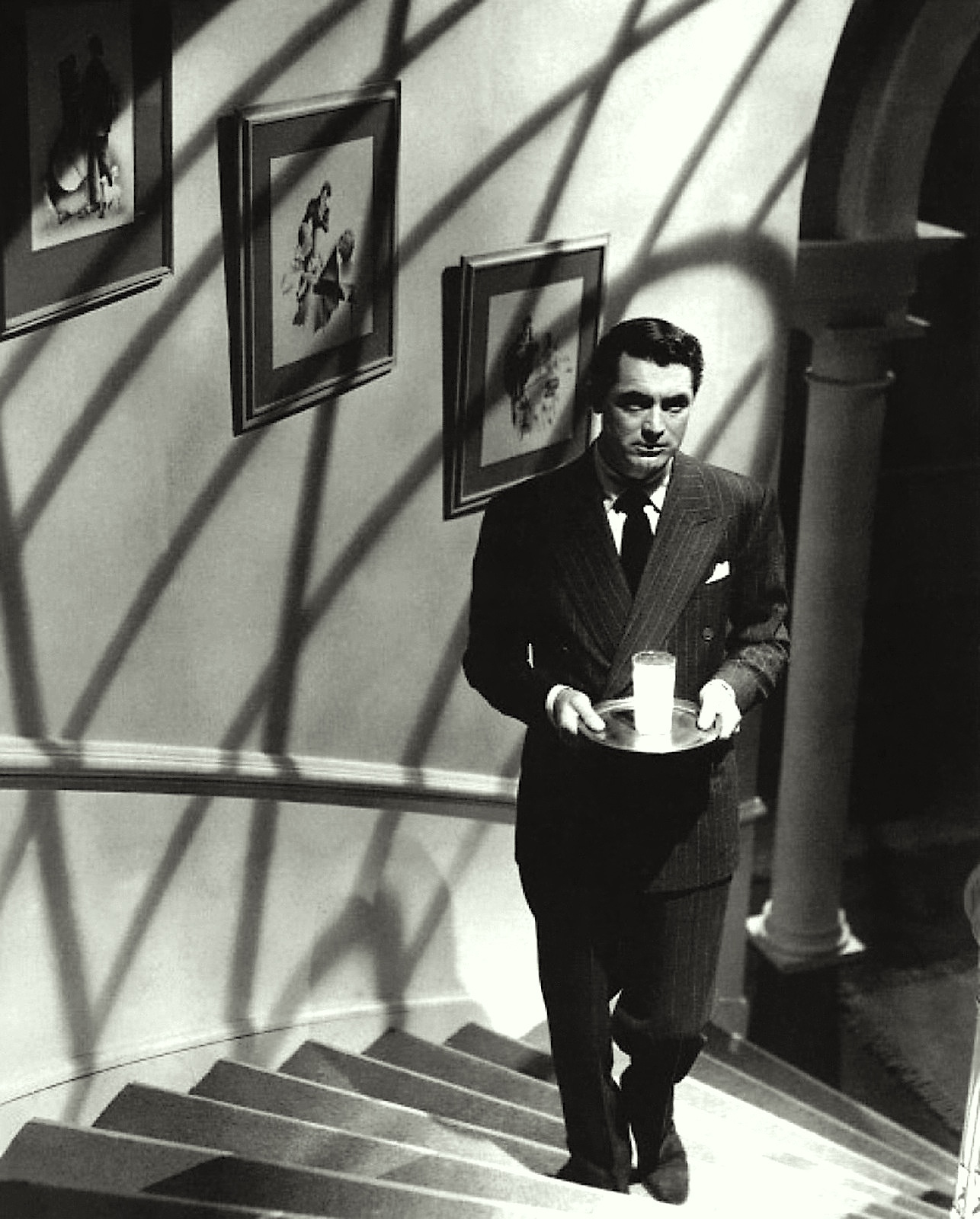MARIANI’S
Virtual
Gourmet
April
12, 2015
NEWSLETTER
IN THIS ISSUE
LEXINGTON, KY
By John Mariani
NEW YORK CORNER
LINCOLN CENTER KITCHEN
By John Mariani
NOTES FROM THE WINE CELLAR
LONG SHADOWS WINERY WAS A LONG SHOT
By Mort Hochstein
❖❖❖
LEXINGTON, KY
By John Mariani
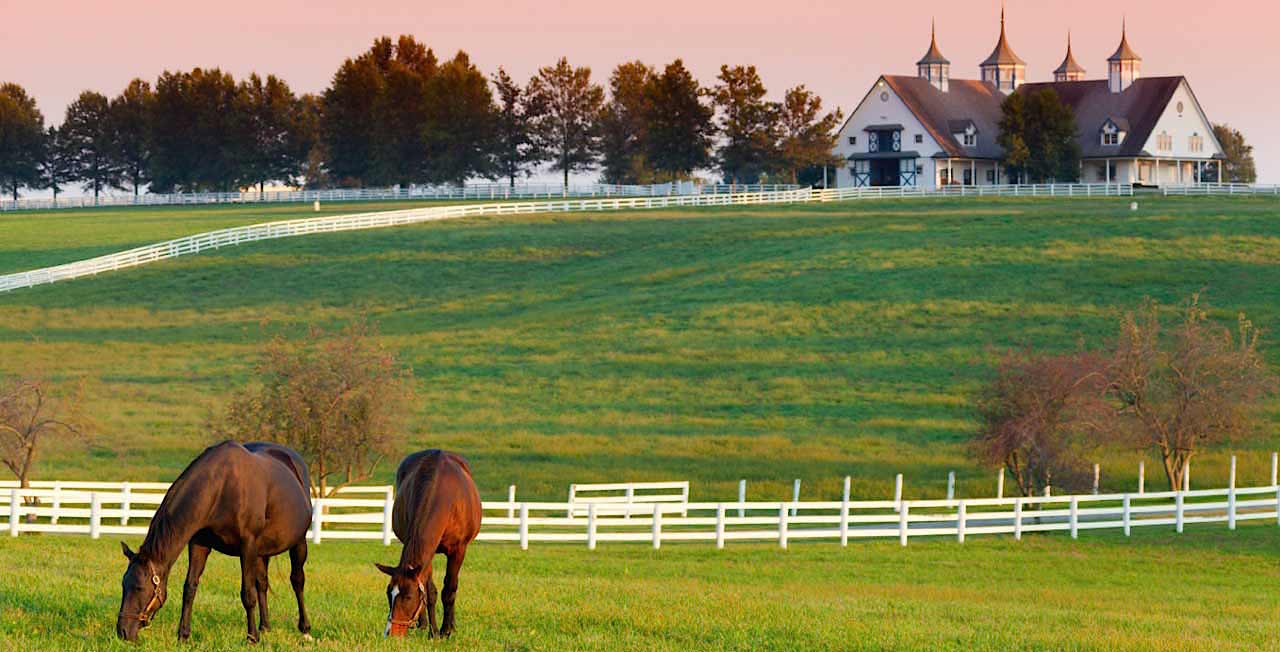
If it’s
springtime in America, there
are few places lovelier to be than
Lexington, Kentucky. The city by that
name is well worth visiting, but it is in
the surrounding hillsides that you find the
soul of the place, especially between April
and October when this “Horse
Capital of the World” showcases thoroughbred
racing by the world's finest horses and jockeys
at Keeneland Race Course, which this October
will host the 2015
Breeders' Cup World Championships.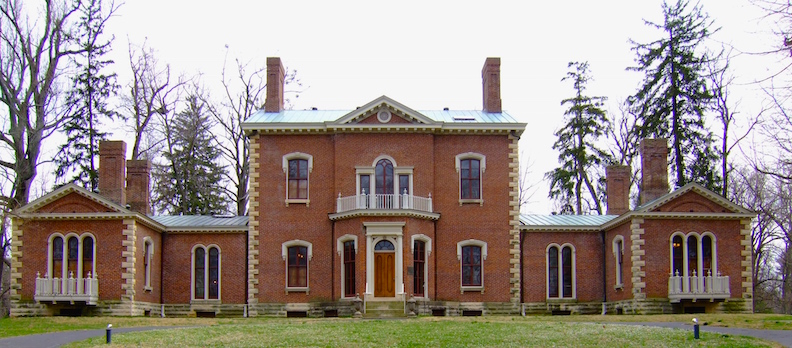
It is also a region rich in
history, including Ashland
(right),
home of the great and brilliant 19th century
statesman Henry Clay, which is set on a 20-acre
wooded estate with an English parterre garden. Guided
tours are given six days a week to this bucolic
spot, of which Clay wrote: "I am
in one respect better off than Moses. He died in
sight of, without reaching, the Promised Land. I
occupy as good a farm as any that he would have
found, if he had reached it; & it has been
acquired not by hereditary descent, but by my own
labor.”
One can also walk the African American Heritage
Trail, created by sociology professor Doris
Wilkinson based on her original brochure "A Guide
to the African American Heritage in Downtown
Lexington, Kentucky."
Kentucky’s native
spirit, bourbon, is proudly boosted around the
region, with six of
the most popular distilleries along the Bourbon
Trail within five to thirty minutes of the city
center. Both
Wild Turkey and Four Roses have new visitor
centers.
It
would be wholly wrong to characterize Lexington’s
gastronomy as awash in grits and barbecue, though
you can readily find both at Billy’s
BAR-B-Q (here since 1978). But there
are also the marvelously evocative Holly Hill
Inn in an 1838 ante-bellum mansion, an
excellent family-run restaurant featuring
traditional and modern cuisine at very good
prices; a charming, family-owned Japanese
restaurant, Yamaguchi’s Sake and Tapas; and an
always convivial fine dining restaurant named Dudley’s
on Short, located in the stately
Northern Bank Building, built in 1889, whose
owner, Debbie Long, knows well the meaning of
personal and culinary largess.
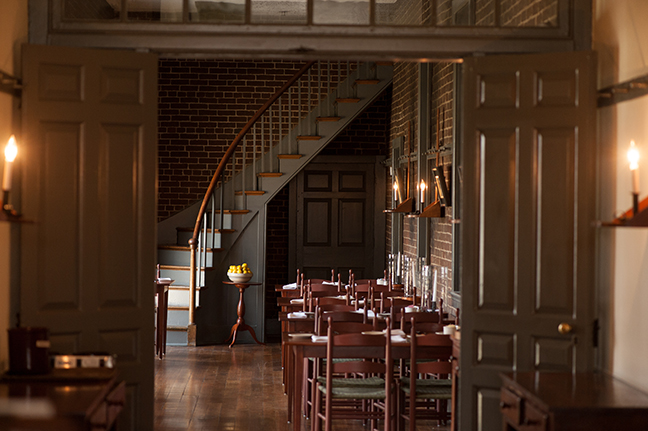 Certainly
unique is the restaurant that is oddly called the
Trustees’
Table at Shaker
Village of Pleasant Hill, which is
the largest restored Shaker community, with 2,900
acres of farmland and 34 renovated 19th century
buildings. Examples of the distinct Shaker design
can be found in every house and piece of
furniture, as it is in the restaurant--where you
need not be a trustee to dine. And the food, whose
ingredients come largely from local gardens,
largely reflects the kind that the community once
would have
consumed, starting with hot corn sticks and a cole
slaw that is far more addictive than the
sober-sided Shakers might have wished.
Certainly
unique is the restaurant that is oddly called the
Trustees’
Table at Shaker
Village of Pleasant Hill, which is
the largest restored Shaker community, with 2,900
acres of farmland and 34 renovated 19th century
buildings. Examples of the distinct Shaker design
can be found in every house and piece of
furniture, as it is in the restaurant--where you
need not be a trustee to dine. And the food, whose
ingredients come largely from local gardens,
largely reflects the kind that the community once
would have
consumed, starting with hot corn sticks and a cole
slaw that is far more addictive than the
sober-sided Shakers might have wished.
There are plump, hot chicken
croquettes chock full of mushrooms, onions, chives
and parsley ($13.95), served with a rich cream
sherry sauce, corn pudding and baby green beans in
dill butter.
I loved the potato and ham soup ($2.95 or
$4.95) and slow-roasted pork on brioche bread
($12.95)--as juicy and delicious as you’ll find in
any local barbecue spot, only here
they add fontina cheese and a sweet pepper relish. Dining
within the walls of this darling restaurant adds
measurably to one’s appreciation of the whole
enterprise at the Village, where, as the old hymn
says, it is indeed a gift to be simple.
The
Trustees’
Table is open daily for lunch and dinner.
One of the favorite
dinner spots in Lexington, in a refurbished
landmark building dating to 1938, is Coles 735
Main,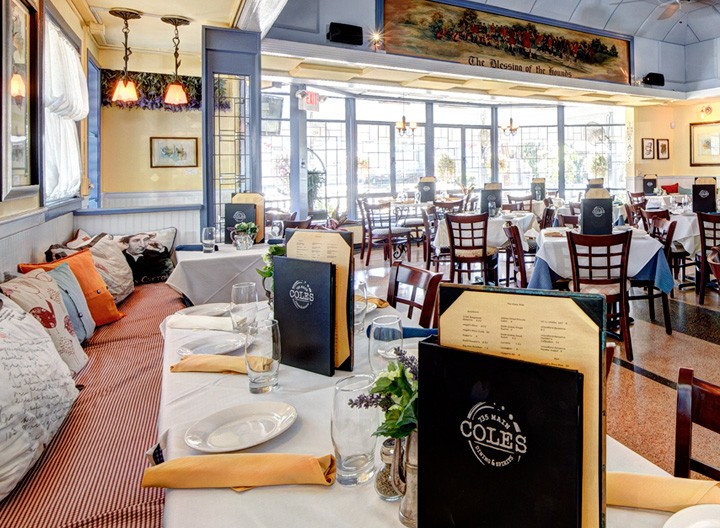 where
just about everybody seems to know each other, not
least the management and wait staff that greets
you. The
interior has history on its side, including three restored English
hunt scene murals that had been painted for the
restaurant in 1949 by local art teacher Theresa
Newhoff, who put local people into the scenes of
the “Blessing of the Hounds.”
where
just about everybody seems to know each other, not
least the management and wait staff that greets
you. The
interior has history on its side, including three restored English
hunt scene murals that had been painted for the
restaurant in 1949 by local art teacher Theresa
Newhoff, who put local people into the scenes of
the “Blessing of the Hounds.”
Native-born chef-owner Cole
Arimes has had long experience at some haute
cuisine restaurants outside of Kentucky, and it
shows in his precision and in the way he imbues
old dishes with bright flourishes. Even a
somewhat questionable idea like panko-crusted
fried avocado worked, not least because it came
with a meaty crab salad and lemon-saffron aïoli
($10). It
was also so good to see that Arimes knows well how
once-dismissed Iceberg lettuce is supposed to
work--with real crunch--under hard-boiled egg,
chives, tomatoes, Gorgonzola, and barrel-smoked
bacon dressing ($8). A pork belly confit with
micro salad and red onion vinaigrette ($12) seems
right at home here, and, if tuna sashimi ($12)
seems far afield, it’s still a pretty good
rendering.
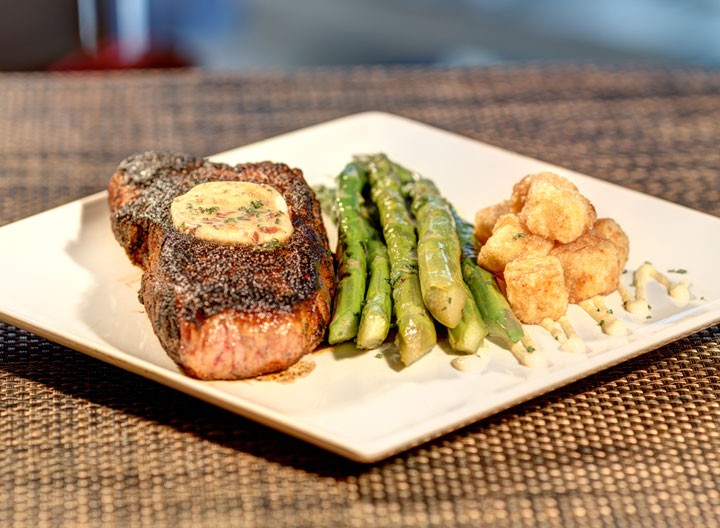 Pastrami
short ribs are cured and smoked in-house, with
wasabi-spiked whipped potatoes, kimchi,
and a delightful sorghum Pommery demi-glace ($30). Best of
all dishes I tried was one urged on me by the
waiter, who promised it would be one of the best
steaks I’ll ever eat. And it was, a Black Angus
strip (left)
of admirable marbling and good minerality, seared
perfectly and oozing red juices, all accompanied
by smoked garlic grits and compound butter--a
steal at $33.
Pastrami
short ribs are cured and smoked in-house, with
wasabi-spiked whipped potatoes, kimchi,
and a delightful sorghum Pommery demi-glace ($30). Best of
all dishes I tried was one urged on me by the
waiter, who promised it would be one of the best
steaks I’ll ever eat. And it was, a Black Angus
strip (left)
of admirable marbling and good minerality, seared
perfectly and oozing red juices, all accompanied
by smoked garlic grits and compound butter--a
steal at $33.
All desserts I
sampled were up to what preceded them, from
bourbon ball flourless chocolate torte with smoked
pecans ($6) to a Key lime pie with Chantilly cream
($7). Coles is all about pleasing the customer,
not by merely giving him what he thinks he wants
to eat but by engaging him to try what he’s going
to end up loving.
Coles
735 Main is open Mon.-Sat for dinner.
For
a charming night out, at a restaurant smack in the
middle of a vineyard, head for Jean Farris Winery,
whose husband-wife owners produce a wide range of
bottlings that include everything from Chardonnay
and Cabernet Sauvignon to “Vintner’s Blended Reds”
like Tempest (Tempranillo, Cabernet Sauvignon and
Cabernet Franc) and Hell Hound, a mongrel mix
named after their dog Hades. 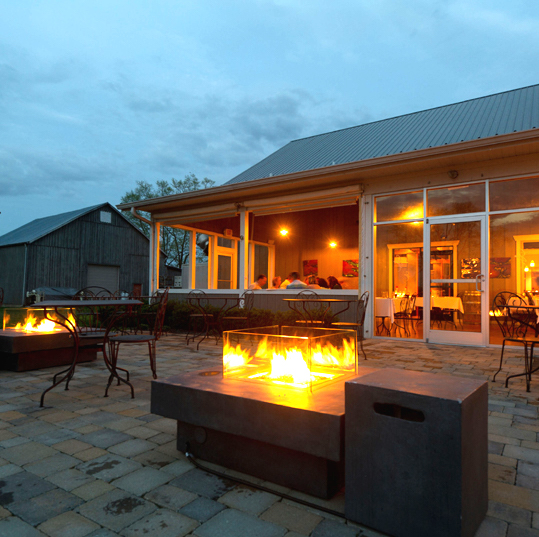
The
dining area is set in a barn-like space--the patio
(right)
is particularly lovely this time of year--and it’s
casual, with plenty of encouragement to try the
estate’s wines by the glass, which match up
splendidly with starters such as the Butcher’s
Board of house-made charcuterie like duck
rillette, pȃté, white fish, truffled lardo and
Kentucky cheese ($16). In addition, there is a
selection of cheeses (one for $6, three for $14),
many of them from the state’s thriving cheese
industry. Too
bad that on the night I was there all cheeses came
to the table cold.
For a main course I went with a fine pork
loin with sweet potato chips, blue cheese, bacon,
Brussels sprouts, and a pepper jelly demi-glace
($26) and a sous-vide slow-cooked duck with kimchi
lentils, orange suprèmes, and sweet soy reduction
($26), which honorably married the best of east
and west flavors.
For dessert the chocolate bourbon tart was
good, but the raspberry cobbler was a reminder of
how cooked fruit and streusel epitomizes class
homespun cookery.
Jean
Farris Winery & Bistro is open for dinner
Tues.-Sat.; The Bar is open Tues.-Sun.; Sunday
Supper is served noon to 7 p.m.
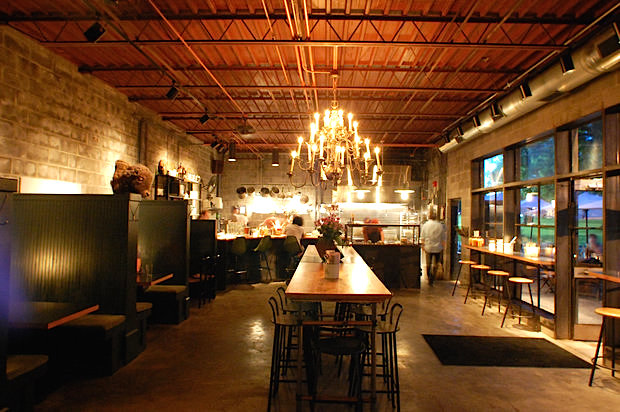 For
something even more down home but seeming very
much up to the moment, try County Club
Restaurant, located within a
renovated garage by owner/chef Johnny Shipley.
It’s a very friendly, very laid-back place, with
roomy booths, concrete walls and black Formica
tables--none of which helps to muffle the booming
‘70s music.
For
something even more down home but seeming very
much up to the moment, try County Club
Restaurant, located within a
renovated garage by owner/chef Johnny Shipley.
It’s a very friendly, very laid-back place, with
roomy booths, concrete walls and black Formica
tables--none of which helps to muffle the booming
‘70s music.
The menu is largely Kentuckian in style,
with some added comfort foods like French-Canadian
poutine--a mound of French fries with gravy and
cheese curds ($12).
The requisite burger ($10) is a winner—a
quarter pound of nicely assembled beef with bacon jam, sharp
cheddar, smoked portabello mushroom and gochujang
ketchup (below).
The chopped
pork sandwich made with smoked shoulder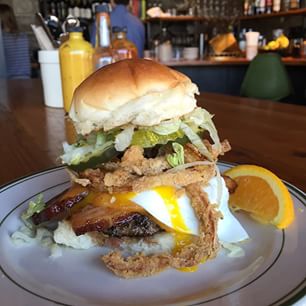 ($8) shows off Shipley’s skill at
slow-roasting and smoking, and his complex sauce
is very important to the final outcome.
($8) shows off Shipley’s skill at
slow-roasting and smoking, and his complex sauce
is very important to the final outcome.
Given the low prices for so much goodness
here, the portions of so-so ice cream at the end
are paltry, but then, they’re not the point of
coming here. You just go, you settle in, you eat,
you grin, you vow to come back soon, and you do,
soon.
County Club
Restaurant is open for lunch Fri. & Sat.,
Brunch on Sun.; Dinner Tues.-Sat.
❖❖❖
By John Mariani
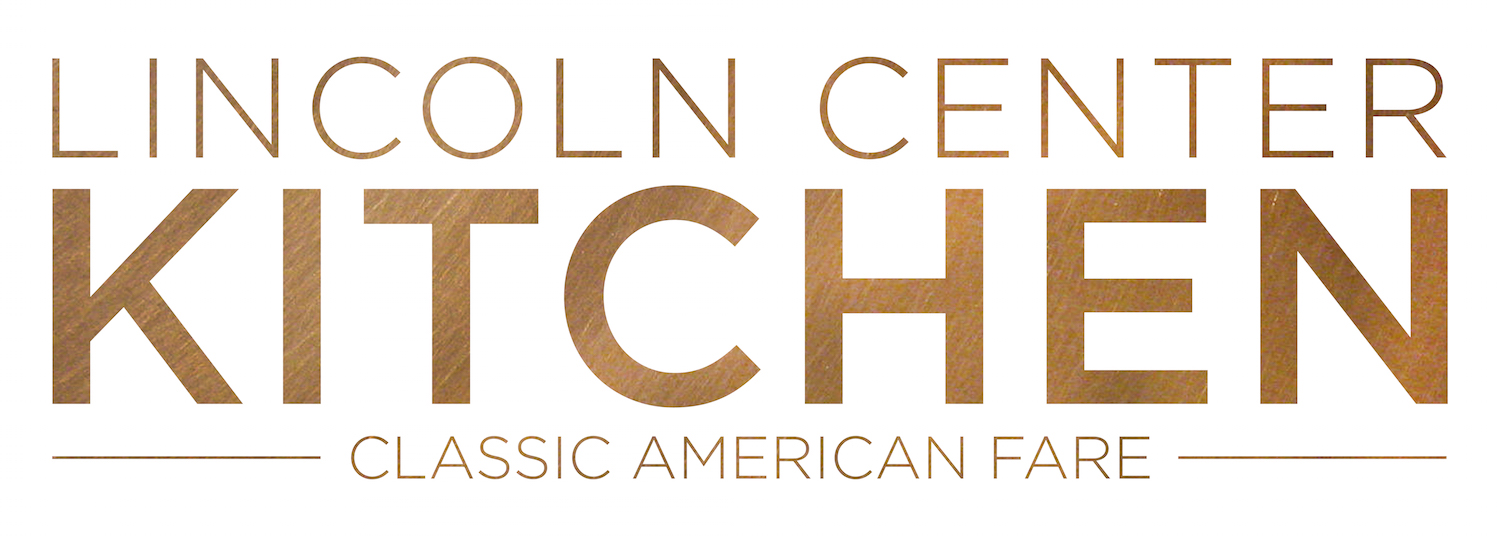
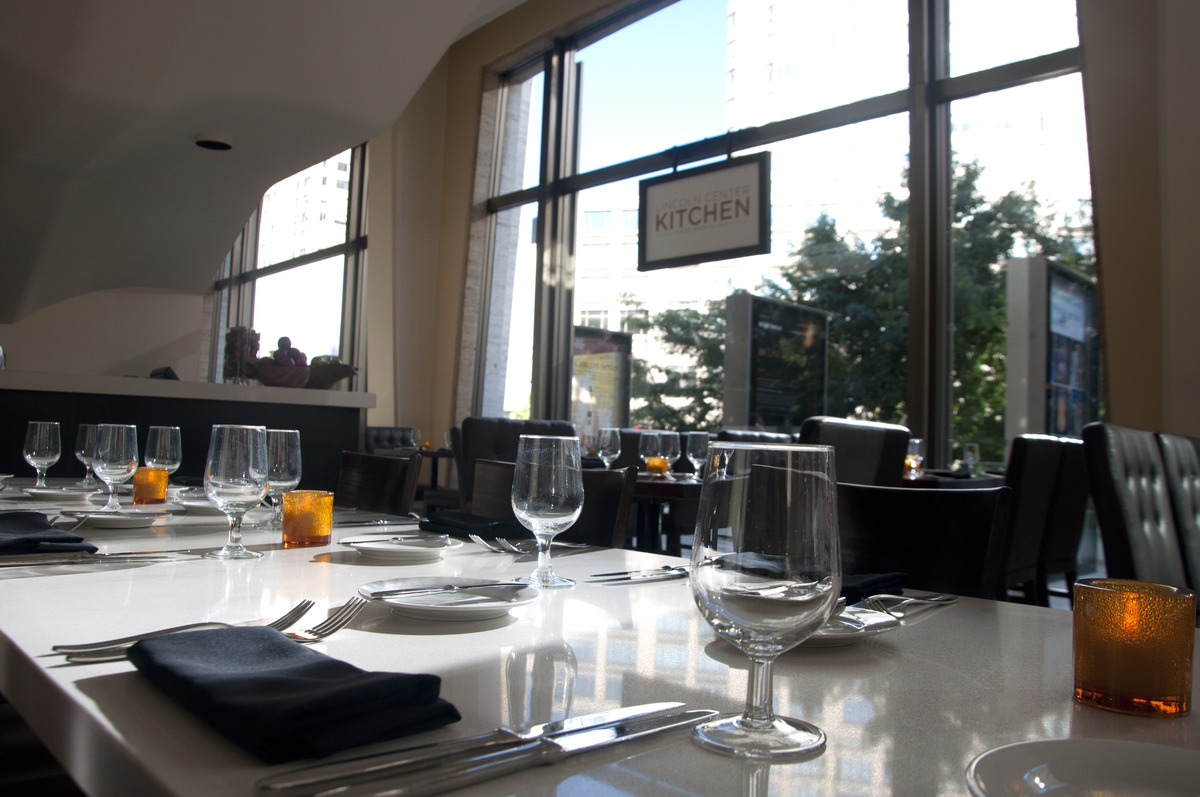
10 Lincoln Square Plaza
212-874-7000
www.lincolncenterkitchen.com.
Naïfs still ask, “But what really is
American food?”
The easy answer is,
anything Americans eat, from Maine lobster to chile
con carne. But
nothing is that easy. Assuming that, like everything
else, American gastronomy gobbles up influences from
all its immigrant cultures, there is by now a
consensus of what an American menu looks like.
For a prime example, head to
Lincoln Center. There you may dine at the 75-seat American
Table Café and Bar by Marcus Samuelsson (an
immigrant from Sweden via Ethiopia); the Munroe Film
Center, where you can enjoy Indie Food
and Wine; the Grand
Tier Restaurant inside the  Metropolitan
Opera House; Lincoln
Ristorante, a stylish Italian restaurant (my
son is g-m there); and Avery Fisher’s Lincoln Center
Kitchen, now overseen by Chef Ed Brown (left), who also
runs Ed Brown’s Chowder House across the street.
Metropolitan
Opera House; Lincoln
Ristorante, a stylish Italian restaurant (my
son is g-m there); and Avery Fisher’s Lincoln Center
Kitchen, now overseen by Chef Ed Brown (left), who also
runs Ed Brown’s Chowder House across the street.
Avery Fisher Hall is due for a
total rehab over the next four years, but Lincoln
Center Kitchen, which has been on the premises for
decades, will stay open throughout much of the
construction phase. So, no need to rush over just
yet. For
the time being, LCK is comprised of two open dining
rooms and a lounge--you look out on the Plaza--with
a large communal high-top table. Three
tree paintings by NYC artist Merle Temkin hang in
the center room.
Go now and you’ll immediately
recognize the American aspects of the menu as well
as global influences--executive chef Daniel
Anconetani is from Argentina--like the best,
meatiest, lump crab cakes in the country, with
grainy mustard and palm cabbage slaw ($38).
Appetizers include deviled eggs (below, right) with
American caviar and crispy bacon ($14); poached
shrimp are treated to a shower of spicy cashews and
a saffron aïoli ($16). A beet and goat's cheese salad
(below, left)
is artfully plated and fresh as April itself. Of
course, there is the inevitable kale salad, laced
with spicy yogurt, pine nuts and parmesan ($15). Meh.
But Brown always gives his
strong, personal stamp to everything, so he makes a
big, buttery, crisp and steamy popover, which he
lavishes with wild mushrooms and fresh herbs. 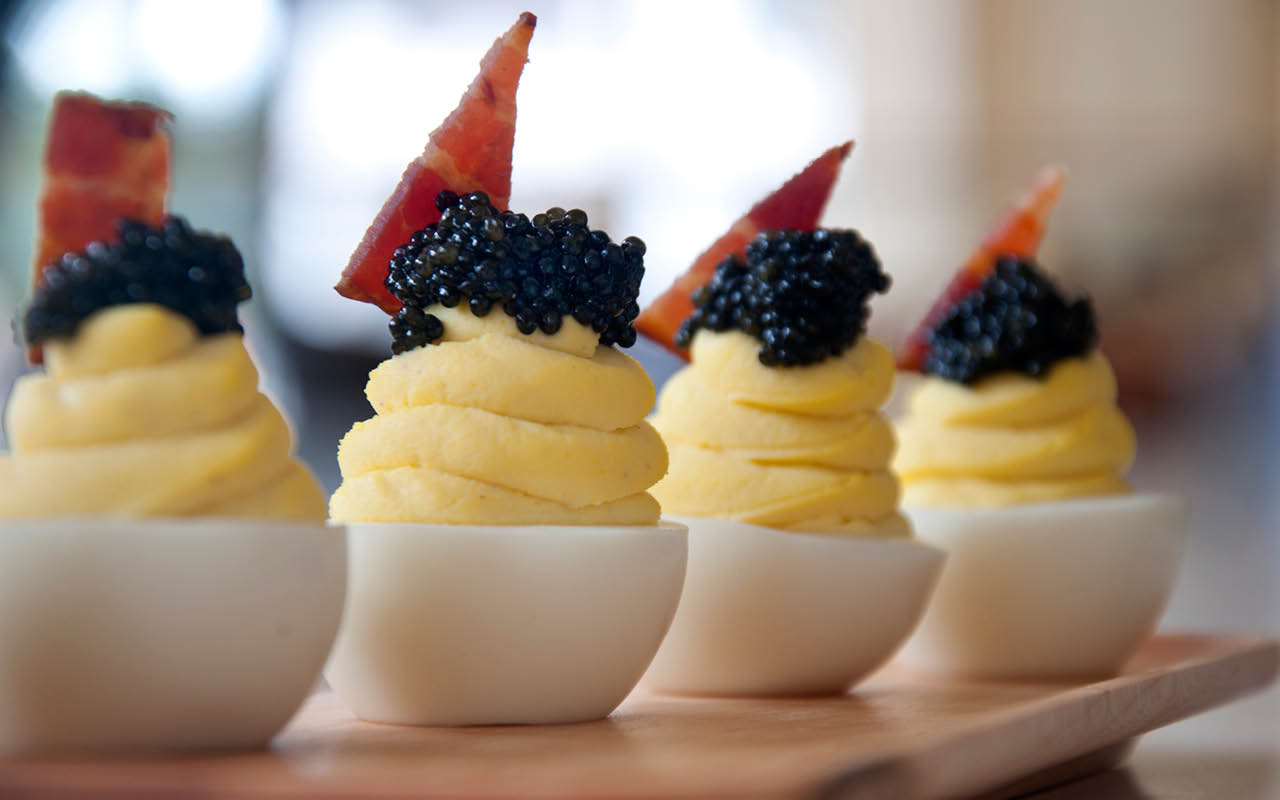 What
could possibly be more American than chicken pot
pie? LCK’s version ($26) is as straightforward as
they come, chock full of big pieces of chicken,
white onions, mushrooms, carrots and peas, but what
distinguishes it is the creamy sauce, as rich as
you’d find in a blanquette de
veau in the best Paris bistros.
What
could possibly be more American than chicken pot
pie? LCK’s version ($26) is as straightforward as
they come, chock full of big pieces of chicken,
white onions, mushrooms, carrots and peas, but what
distinguishes it is the creamy sauce, as rich as
you’d find in a blanquette de
veau in the best Paris bistros.
There’s a
dish called “spaghetti-spaghetti” that incorporates
whole wheat pasta with carrot, zucchini, yellow
squash strips and good pecorino ($23) that really
works in terms of texture, nuttiness, and
springtime.
Brown always has exciting
specials--the night I dined there a black bass crudo with
olive oil, orange, mint, radish, flowering cucumber
and sea salt, everything in perfect, subtle balance.
Black bass also figured as a main course, roasted
with purple cauliflower, Sicilian tuna, garlic, a
hit of chili, a spike of lemon zest, and nicely
acidic lemon verbena. Braised shortrib was a lusty,
dark, winey dish with unimaginably buttery pureed
potatoes, and sweet Thumbelina carrots. There was
also a whole roast squab, cooked just to the point
of pinkness that revealed the most flavor, served
with red cabbage, kale, Fuji apple and the rich
liver of the squab.
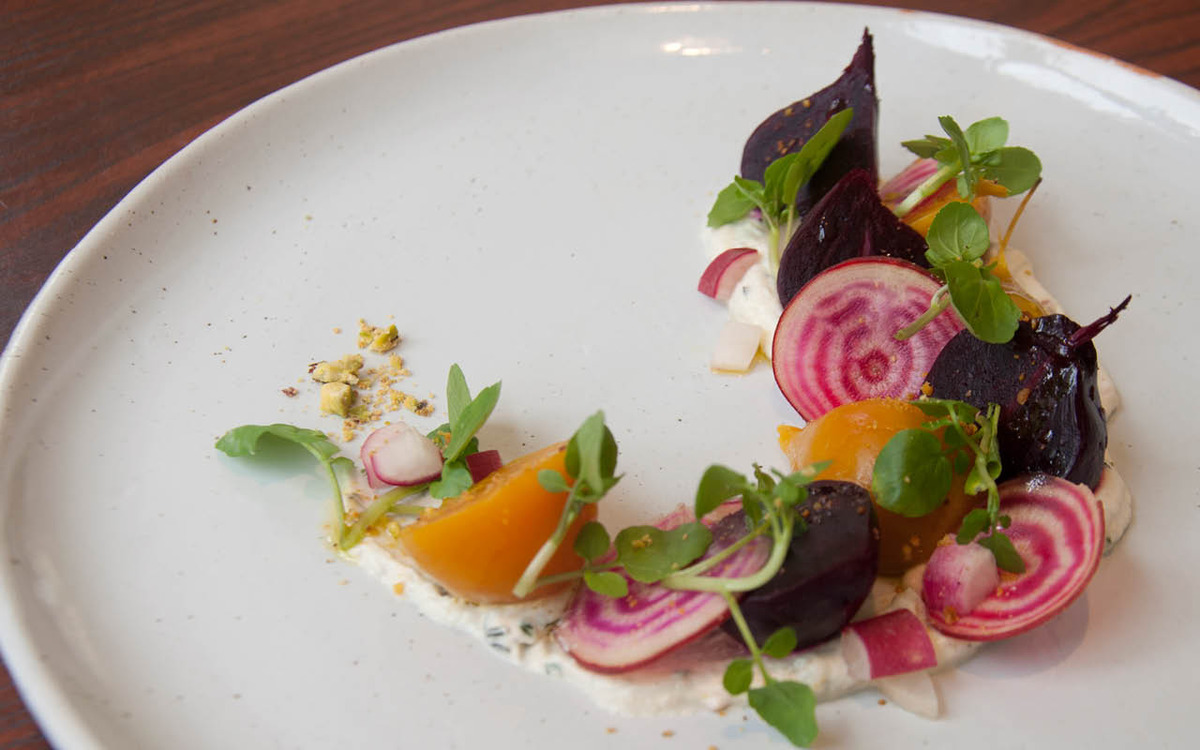 You
may have an American cheese plate with bread and
figs ($16) instead of dessert, or a fine molten
chocolate cake with pistachio ice cream ($14).
You
may have an American cheese plate with bread and
figs ($16) instead of dessert, or a fine molten
chocolate cake with pistachio ice cream ($14).
So, if a friend is visiting from
abroad--especially one with an interest in music and
Lincoln Center--you can treat him to a very
delicious lesson in American cooking at LCK, along
with a good dose of American hospitality and some
spectacular NYC architecture. And Broadway runs
right by it.
Lunch is Sat. & Sun.; dinner Tues.-Sat.. There
is a seasonal Chef’s Menu offered
for $47 per person.
❖❖❖
LONG SHADOWS WINERY
WAS A LONG SHOT
By Mort Hochstein
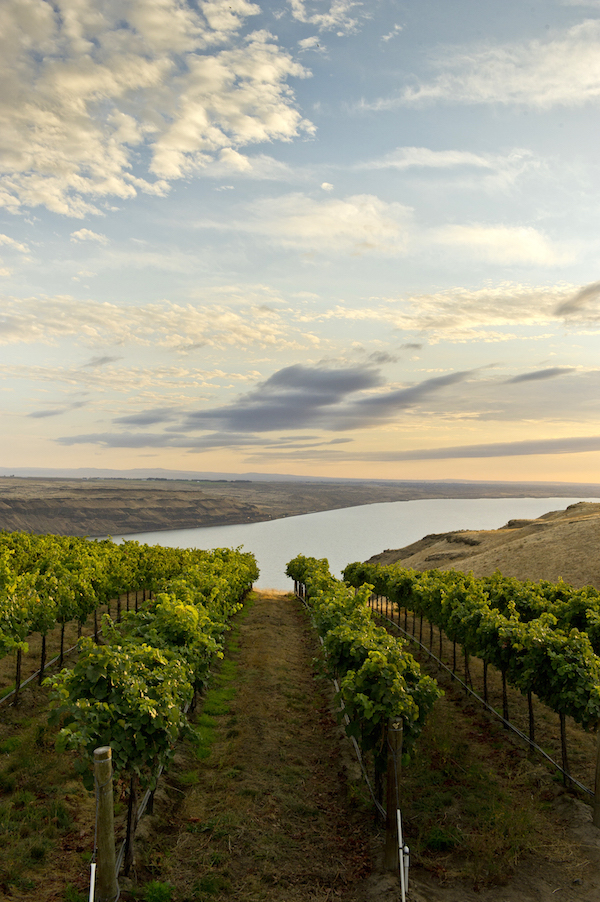 I
met Allen Shoup many years ago, when we tasted his
line of wines in a modest tavern in Manhattan.
Although he was the CEO of Stimson Lane, then a
fledgling Washington state wine company, he was
working the New York wine market like an ordinary
street salesman, knocking on doors and trying to
interest buyers in wines from a little known
region.
I
met Allen Shoup many years ago, when we tasted his
line of wines in a modest tavern in Manhattan.
Although he was the CEO of Stimson Lane, then a
fledgling Washington state wine company, he was
working the New York wine market like an ordinary
street salesman, knocking on doors and trying to
interest buyers in wines from a little known
region.
In those same years, Robert Mondavi was
also on the road, campaigning to bring California
wines to Eastern markets dominated by European
imports. The pioneering ventures of Mondavi
and Shoup raced along parallel tracks for several
decades. In the same way that Mondavi attracted
attention for California, Shoup made buyers
familiar with Chateau Ste. Michelle and wines from
Washington. California’s vineyards boomed in the
'80s, and Chateau Ste. Michelle and its neighbors
in the Columbia Valley also prospered. Today
Washington rocks with 850 wineries, second only to
California.
In 1979 Mondavi created the super premium Opus One
Cabernet Sauvignon in a joint venture with Baron
Philippe de Rothschild of Chȃteau Mouton
Rothschild. Opus One brought international
attention to Napa. Shoup commented many
years later, “Bob Mondavi realized that he could
gain credibility for American wines by partnering
with famous European houses. He was an inspiration
to me.”
At Chateau Ste. Michelle, Shoup adopted a
similar strategy. “At the time Mondavi
created Opus One, I thought seriously about a
similar project with May de Lecquesaing, owner of
Pichon-Lalande in Bordeaux. She loved Washington
wines, and we tried for years to put together a
joint venture à la Opus, but it never happened.”
Instead, in 1996, Shoup induced Piero Antinori, a
leader of the Italian wine industry, to partner
with Chateau Ste. Michelle, producing Col Solare,
a Bordeaux blend emphasizing Syrah from the
Columbia Valley. Three years later, together with
Ernst Loosen from Dr. Loosen of Germany, he
created Loosen’s Eroica, which has been
credited with popularizing Riesling in America,
where until recently that varietal was often
neglected.
In 2002, after building Stimson Lane
Wineries and Estates into a giant house with
multiple labels in Washington, Conn Creek and
Villa Mt. Eden in California, and brand ventures
in Chile, France and Australia, Shoup (below) moved
on. He had another vision to pursue and spent the
next 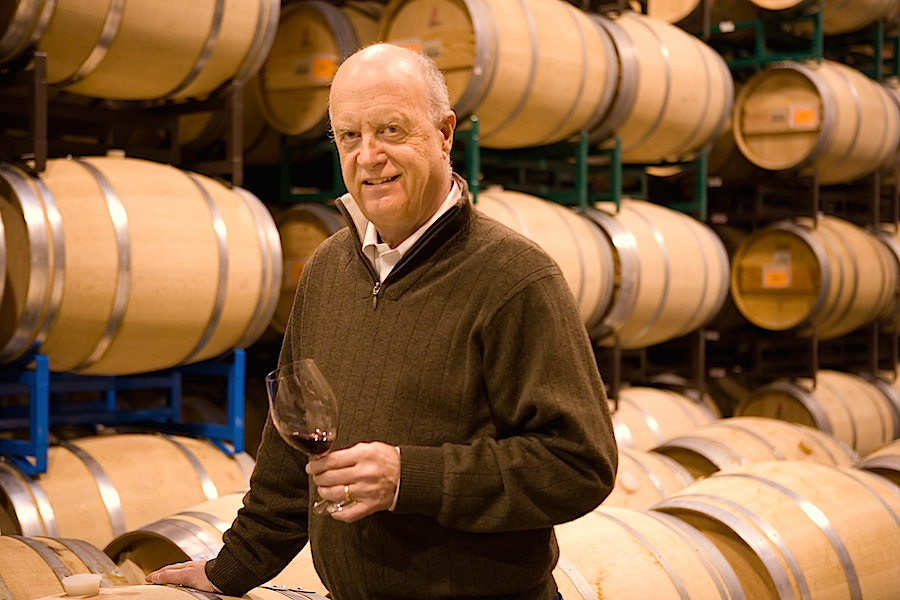 two years
inducing industry icons to join him in a venture
to be known as Long Shadows Winery. Each member
would be an owner-partner, making one unique
premium wine from Washington grapes. “I
wanted to name our project after Bob Mondavi,” he
recalled recently, “but we couldn’t overcome the
legalities. So it became Long Shadows, honoring
him indirectly, since he cast such a long shadow
over the American wine industry." At a well
equipped facility in Walla Walla, Shoup’s all-star
team of winemakers has produced a series of
stylish wines that have won awards and high
ratings since their inception.
two years
inducing industry icons to join him in a venture
to be known as Long Shadows Winery. Each member
would be an owner-partner, making one unique
premium wine from Washington grapes. “I
wanted to name our project after Bob Mondavi,” he
recalled recently, “but we couldn’t overcome the
legalities. So it became Long Shadows, honoring
him indirectly, since he cast such a long shadow
over the American wine industry." At a well
equipped facility in Walla Walla, Shoup’s all-star
team of winemakers has produced a series of
stylish wines that have won awards and high
ratings since their inception.
By
contemporary standards, particularly for top-shelf
winemakers, the Long Shadows line is moderately
priced. The winemakers are Randy Dunn of Napa for
Feather
Cabernet Sauvignon ($60); Armin Diehl of
Germany for Poet’s Leap
Riesling ($20); international wine
consultant Michelle Rolland for Pedestal
Merlot ($60); John Duval, former winemaker
for Penfolds Grange of Australia, for Sequel
Syrah ($50); Napa pioneer and winemaker
Philippe Melka for Pirouette
Red, a Bordeaux-style wine ($60) and
Ambrogio and Giovanni Folonari of Italy for Saggi,
a super-Tuscan red blend ($45). Gilles Nicault,
resident winemaker, is general overseer for all
these projects. He also produces a new world red
blend, Chester
Kidder ($50), honoring Shoup’s
grandfather, Charles Chester, and grandmother,
Maggie Kidder.
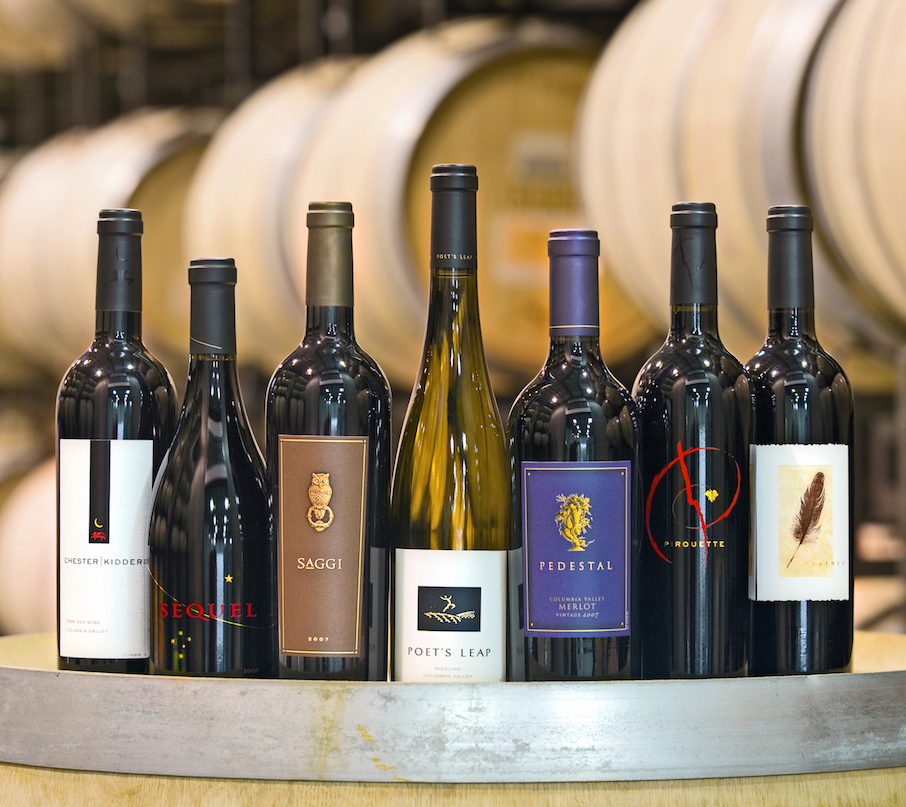 Nicault,
trained in his native France, has worked in
Washington since 1994, most notably with the
premier Cabernet house Woodward Canyon, and he now
assists Shoup’s distinguished visitors. “While
there may be some traditional methods,” he
observes, “no winemaker is the same.” Shepherding
the visiting winemakers at Walla Walla requires
great flexibility to accommodate the variety of
techniques and equipment needed by the
owner-partners. It also requires them to adjust to
the vast distances they must traverse to inspect
vineyards and source fruit.
Nicault,
trained in his native France, has worked in
Washington since 1994, most notably with the
premier Cabernet house Woodward Canyon, and he now
assists Shoup’s distinguished visitors. “While
there may be some traditional methods,” he
observes, “no winemaker is the same.” Shepherding
the visiting winemakers at Walla Walla requires
great flexibility to accommodate the variety of
techniques and equipment needed by the
owner-partners. It also requires them to adjust to
the vast distances they must traverse to inspect
vineyards and source fruit.
Now in its second decade, Long Shadows has
become one of Washington’s leading
wineries. Before getting underway, Shoup
sought Mondavi out and wanted to enlist him in the
project. “Bob Mondavi’s encouragement,” he
observed, “was critical to my decision to move
ahead. He thought it was a no-brainer.”
But, while Mondavi
thoroughly approved, he resisted Shoup’s
invitation to come aboard, saying, “I’m 90 at this
point and would gladly participate if I were ten
years younger.” The godfather of the California
wine explosion lived to the age of 95, long enough
to watch his pioneering Washington counterpart
establish yet innovative project.
❖❖❖

WE'VE ALREADY GOT IT ON SPEED
DIAL!
MUNCHIES
has
just released a new documentary entitled MUNCHIES Presents: Insects,
Testicles, and the Paleo Diet. In
the video, Berlin chef Boris Leite Poço, who has opened
the world's first Paleo restaurant, Sauvage, offers
a three course meal that includes lamb testicles with
parsnips and celeriac; a raw biscuit made from dried
fruits, cocoa beans, hazelnuts and mealworms; and bone
marrow with mealworm crackers.

FROM THE TAKE-OUT ONLY LINE!
An
impatient Texan who couldn't stand waiting in the
Whataburger drive-through line was arrested after he
chose to impersonate a police officer by wheeling into
the parking lot in a Dodge truck he'd outfitted
with sirens and flashing lights, forcing the other
cars to move out of the way. A nearby off-duty cop
nearby became suspicious and arrested the man who
faces up to ten years in prison.
The
Legend of Principessa Gavia
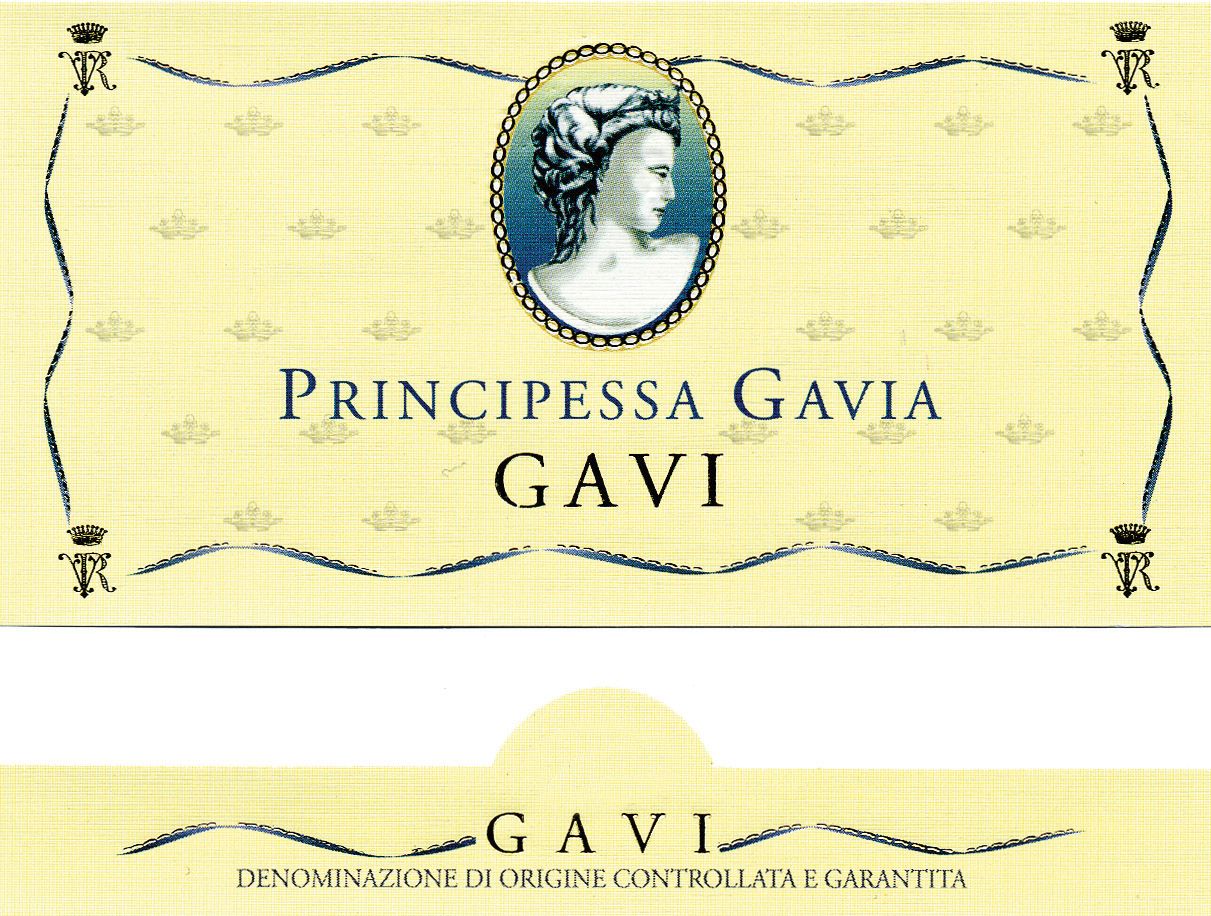 Once
upon a time in a land far away, there lived a fair
young princess named Gavia, daughter of Clodimir,
king of the Franks and son of Clovis I. As young
maidens are wont to do, she fell in love with a
handsome young man who served as a guard in her
father's court. The couple sought the king's
permission to marry, but he refused to have his
daughter wed out of her class. He forbade them to
see each other. Desperately in love, the young
couple eloped, fleeing to a distant part of the
kingdom and settling in a sleepy village on the
other side of the alps.
Once
upon a time in a land far away, there lived a fair
young princess named Gavia, daughter of Clodimir,
king of the Franks and son of Clovis I. As young
maidens are wont to do, she fell in love with a
handsome young man who served as a guard in her
father's court. The couple sought the king's
permission to marry, but he refused to have his
daughter wed out of her class. He forbade them to
see each other. Desperately in love, the young
couple eloped, fleeing to a distant part of the
kingdom and settling in a sleepy village on the
other side of the alps.
For a long time, they eluded the
king's troops who scoured the land in search of the
newlyweds. Alas, one night after enjoying a generous
amount of a charming local white wine, the groom
became loose-lipped and confided their story to the
local innkeeper. The innkeeper nodded and feigned
sympathy, but after sending the groom off to bed he
sent word to the king and collected a handsome
reward. Troops gathered up the couple and brought
them back to the king to face their punishment.
By this time word of the romance
had spread throughout the kingdom, and there were
intercessions on Gavia's behalf by Alamasunta, Queen
of the Goths, as well as Pope St. Hermistas. The
King, of course, upon looking into his lovely
daughter's eyes, could not help but forgive her. He
blessed their union, and as a wedding gift he
bequeathed them the town which they had chosen to
settle in. In her honor he gave the name Gavi to the
town as well as the charming white wine that was
responsible for her husband's indiscretion.
It is said today that the romance lives
on in each glass of Principessa Gavia Gavi.
Any of John Mariani's books below may be ordered from amazon.com.
 I'm proud and happy to announce that my
new book, The Hound
in Heaven (21st Century Lion Books), has just
been published through Amazon and Kindle.
I'm proud and happy to announce that my
new book, The Hound
in Heaven (21st Century Lion Books), has just
been published through Amazon and Kindle. It is a novella, and for anyone who loves dogs, Christmas, romance, inspiration, even the supernatural, I hope you'll find this to be a treasured favorite. The story concerns how, after a New England teacher, his wife and their two daughters adopt a stray puppy found in their barn in northern Maine, their lives seem full of promise. But when tragedy strikes, their wonderful dog Lazarus and the spirit of Christmas are the only things that may bring back his master back from the edge of despair.
WATCH THE VIDEO!
“What a huge surprise turn this story took! I was completely stunned! I truly enjoyed this book and its message.” – Actress Ali MacGraw
“He had me at Page One. The amount of heart, human insight, soul searching, and deft literary strength that John Mariani pours into this airtight novella is vertigo-inducing. Perhaps ‘wow’ would be the best comment.” – James Dalessandro, author of Bohemian Heart and 1906.
“John Mariani’s Hound in Heaven starts with a well-painted portrayal of an American family, along with the requisite dog. A surprise event flips the action of the novel and captures us for a voyage leading to a hopeful and heart-warming message. A page turning, one sitting read, it’s the perfect antidote for the winter and promotion of holiday celebration.” – Ann Pearlman, author of The Christmas Cookie Club and A Gift for my Sister.
“John Mariani’s concise, achingly beautiful novella pulls a literary rabbit out of a hat – a mash-up of the cosmic and the intimate, the tragic and the heart-warming – a Christmas tale for all ages, and all faiths. Read it to your children, read it to yourself… but read it. Early and often. Highly recommended.” – Jay Bonansinga, New York Times bestselling author of Pinkerton’s War, The Sinking of The Eastland, and The Walking Dead: The Road To Woodbury.
“Amazing things happen when you open your heart to an animal. The Hound in Heaven delivers a powerful story of healing that is forged in the spiritual relationship between a man and his best friend. The book brings a message of hope that can enrich our images of family, love, and loss.” – Dr. Barbara Royal, author of The Royal Treatment.
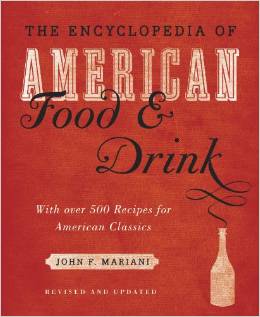 |
The Encyclopedia of American Food and Drink by John F. Mariani (Bloomsbury USA, $35) Modesty forbids me to praise my own new book, but let me proudly say that it is an extensive revision of the 4th edition that appeared more than a decade ago, before locavores, molecular cuisine, modernist cuisine, the Food Network and so much more, now included. Word origins have been completely updated, as have per capita consumption and production stats. Most important, for the first time since publication in the 1980s, the book includes more than 100 biographies of Americans who have changed the way we cook, eat and drink -- from Fannie Farmer and Julia Child to Robert Mondavi and Thomas Keller. "This book is amazing! It has entries for everything from `abalone' to `zwieback,' plus more than 500 recipes for classic American dishes and drinks."--Devra First, The Boston Globe. "Much needed in any kitchen library."--Bon Appetit. |
"Eating Italian will never be the same after reading John Mariani's entertaining and savory gastronomical history of the cuisine of Italy and how it won over appetites worldwide. . . . This book is such a tasteful narrative that it will literally make you hungry for Italian food and arouse your appetite for gastronomical history."--Don Oldenburg, USA Today. "Italian
restaurants--some good, some glitzy--far
outnumber their French rivals. Many of
these establishments are zestfully described
in How Italian Food Conquered the World, an
entertaining and fact-filled chronicle by
food-and-wine correspondent John F.
Mariani."--Aram Bakshian Jr., Wall Street
Journal.
"Equal parts
history, sociology, gastronomy, and just
plain fun, How Italian Food Conquered the
World tells the captivating and delicious
story of the (let's face it) everybody's
favorite cuisine with clarity, verve and
more than one surprise."--Colman Andrews,
editorial director of The Daily
Meal.com. "A fantastic and fascinating
read, covering everything from the influence
of Venice's spice trade to the impact of
Italian immigrants in America and the
evolution of alta cucina. This book will
serve as a terrific resource to anyone
interested in the real story of Italian
food."--Mary Ann Esposito, host of PBS-TV's
Ciao
Italia. "John Mariani has written the
definitive history of how Italians won their
way into our hearts, minds, and
stomachs. It's a story of pleasure over
pomp and taste over technique."--Danny Meyer,
owner of NYC restaurants Union Square
Cafe, The Modern, and Maialino.
|
 |
 |
 |
 |
 |
 |
 |
 |
 Everett Potter's Travel Report:
Everett Potter's Travel Report: 
 Eating Las
Vegas is the new on-line site for
Virtual Gourmet contributor John A. Curtas.,
who since 1995 has been commenting on the
Las Vegas food scene and reviewing
restaurants for Nevada Public Radio.
He is also the restaurant critic for KLAS
TV, Channel 8 in Las Vegas, and his past
reviews can be accessed at KNPR.org.
Click on the logo below to go directly to
his site.
Eating Las
Vegas is the new on-line site for
Virtual Gourmet contributor John A. Curtas.,
who since 1995 has been commenting on the
Las Vegas food scene and reviewing
restaurants for Nevada Public Radio.
He is also the restaurant critic for KLAS
TV, Channel 8 in Las Vegas, and his past
reviews can be accessed at KNPR.org.
Click on the logo below to go directly to
his site.

Tennis Resorts Online: A Critical Guide to the World's Best Tennis Resorts and Tennis Camps, published by ROGER COX, who has spent more than two decades writing about tennis travel, including a 17-year stretch for Tennis magazine. He has also written for Arthur Frommer's Budget Travel, New York Magazine, Travel & Leisure, Esquire, Money, USTA Magazine, Men's Journal, and The Robb Report. He has authored two books-The World's Best Tennis Vacations (Stephen Greene Press/Viking Penguin, 1990) and The Best Places to Stay in the Rockies (Houghton Mifflin, 1992 & 1994), and the Melbourne (Australia) chapter to the Wall Street Journal Business Guide to Cities of the Pacific Rim (Fodor's Travel Guides, 1991).


MARIANI'S VIRTUAL GOURMET
NEWSLETTER is published weekly. Editor/Publisher: John
Mariani.
Editor: Walter Bagley. Contributing Writers: Christopher Mariani,
Robert Mariani, Misha
Mariani,
John A. Curtas, Edward Brivio, Mort Hochstein,
Andrew Chalk, Dotty Griffith and Brian Freedman. Contributing
Photographers: Galina Dargery, Bobby
Pirillo. Technical Advisor: Gerry McLoughlin.
To un-subscribe from this newsletter,click here.
© copyright John Mariani 2015
